
xlstm
Official repository of the xLSTM.
Stars: 1740
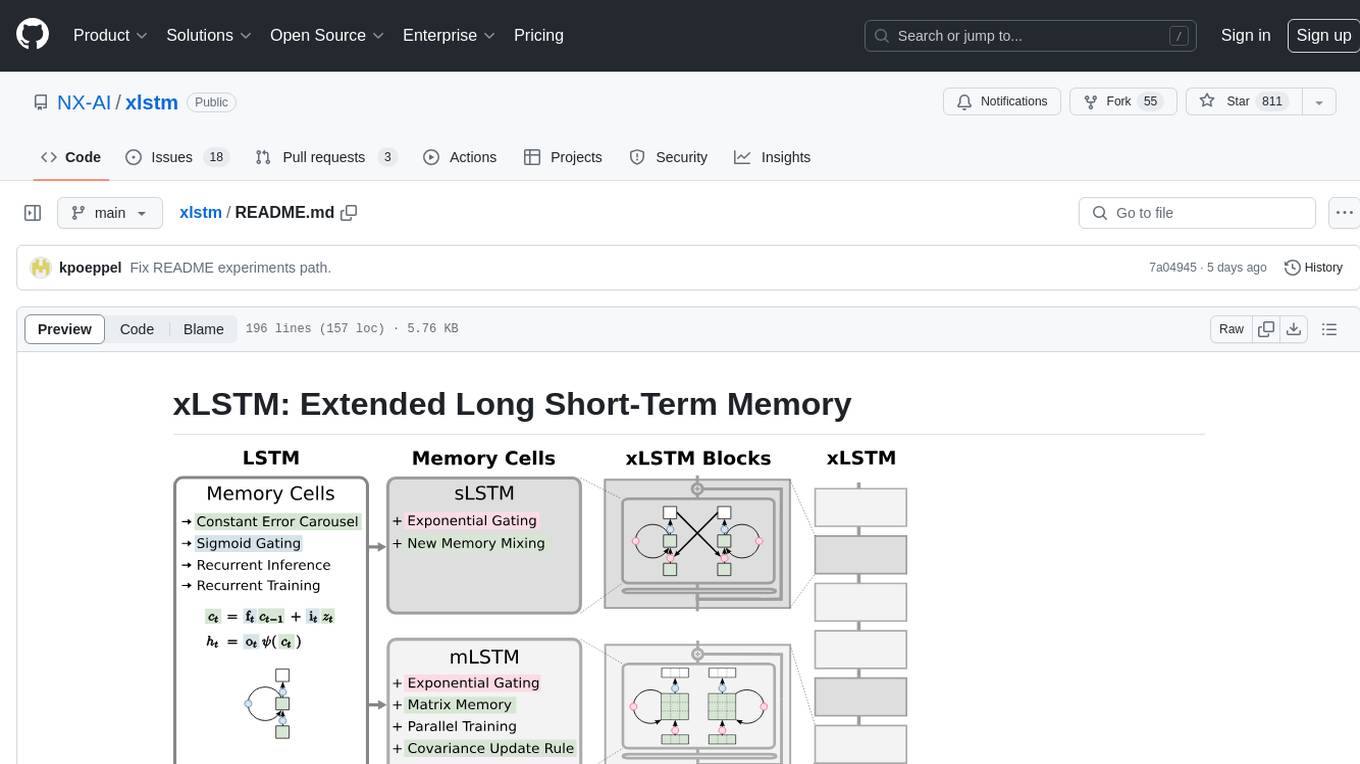
xLSTM is a new Recurrent Neural Network architecture based on ideas of the original LSTM. Through Exponential Gating with appropriate normalization and stabilization techniques and a new Matrix Memory it overcomes the limitations of the original LSTM and shows promising performance on Language Modeling when compared to Transformers or State Space Models. The package is based on PyTorch and was tested for versions >=1.8. For the CUDA version of xLSTM, you need Compute Capability >= 8.0. The xLSTM tool provides two main components: xLSTMBlockStack for non-language applications or integrating in other architectures, and xLSTMLMModel for language modeling or other token-based applications.
README:
xLSTM is a new Recurrent Neural Network architecture based on ideas of the original LSTM. Through Exponential Gating with appropriate normalization and stabilization techniques and a new Matrix Memory it overcomes the limitations of the original LSTM and shows promising performance on Language Modeling when compared to Transformers or State Space Models.
🚨 We trained a 7B parameter xLSTM Language Model 🚨
We have optimized the xLSTM architecture in terms of training throughput and stability.
The code for the updated architecture is located in xlstm/xlstm_large.
The model weights are available on Huggingface at https://huggingface.co/NX-AI/xLSTM-7b.
Create a conda environment from the file environment_pt220cu121.yaml.
Install the model code only (i.e. the module xlstm) as package:
Install via pip:
pip install xlstmClone from github:
git clone https://github.com/NX-AI/xlstm.git
cd xlstm
pip install -e .For using the 7B xLSTM model install mlstm_kernels via:
pip install mlstm_kernels
This package is based on PyTorch and was tested for versions >=1.8. For the CUDA version of sLSTM, you need Compute Capability >= 8.0, see https://developer.nvidia.com/cuda-gpus. For a well-tested environment, install the environment_pt220cu121.yaml as:
conda env create -n xlstm -f environment_pt220cu121.yaml
conda activate xlstmFor the xLSTM Large 7B model we require our mlstm_kernels (TODO add github link) package, which provides fast kernels for the xLSTM.
This section explains how to use the models from the xLSTM paper.
For non language applications or for integrating in other architectures you can use the xLSTMBlockStack and for language modeling or other token-based applications you can use the xLSTMLMModel.
The xLSTMBLockStack is meant for use as alternative backbone in existing projects. It is similar to a stack of Transformer blocks, but uses xLSTM blocks:
import torch
from xlstm import (
xLSTMBlockStack,
xLSTMBlockStackConfig,
mLSTMBlockConfig,
mLSTMLayerConfig,
sLSTMBlockConfig,
sLSTMLayerConfig,
FeedForwardConfig,
)
cfg = xLSTMBlockStackConfig(
mlstm_block=mLSTMBlockConfig(
mlstm=mLSTMLayerConfig(
conv1d_kernel_size=4, qkv_proj_blocksize=4, num_heads=4
)
),
slstm_block=sLSTMBlockConfig(
slstm=sLSTMLayerConfig(
backend="cuda",
num_heads=4,
conv1d_kernel_size=4,
bias_init="powerlaw_blockdependent",
),
feedforward=FeedForwardConfig(proj_factor=1.3, act_fn="gelu"),
),
context_length=256,
num_blocks=7,
embedding_dim=128,
slstm_at=[1],
)
xlstm_stack = xLSTMBlockStack(cfg)
x = torch.randn(4, 256, 128).to("cuda")
xlstm_stack = xlstm_stack.to("cuda")
y = xlstm_stack(x)
y.shape == x.shapeIf you are working with yaml strings / files for configuration you can also use dacite to create the config dataclasses. This is the same as the snippet above:
from omegaconf import OmegaConf
from dacite import from_dict
from dacite import Config as DaciteConfig
from xlstm import xLSTMBlockStack, xLSTMBlockStackConfig
xlstm_cfg = """
mlstm_block:
mlstm:
conv1d_kernel_size: 4
qkv_proj_blocksize: 4
num_heads: 4
slstm_block:
slstm:
backend: cuda
num_heads: 4
conv1d_kernel_size: 4
bias_init: powerlaw_blockdependent
feedforward:
proj_factor: 1.3
act_fn: gelu
context_length: 256
num_blocks: 7
embedding_dim: 128
slstm_at: [1]
"""
cfg = OmegaConf.create(xlstm_cfg)
cfg = from_dict(data_class=xLSTMBlockStackConfig, data=OmegaConf.to_container(cfg), config=DaciteConfig(strict=True))
xlstm_stack = xLSTMBlockStack(cfg)
x = torch.randn(4, 256, 128).to("cuda")
xlstm_stack = xlstm_stack.to("cuda")
y = xlstm_stack(x)
y.shape == x.shapeThe xLSTMLMModel is a wrapper around the xLSTMBlockStack that adds the token embedding and lm head.
from omegaconf import OmegaConf
from dacite import from_dict
from dacite import Config as DaciteConfig
from xlstm import xLSTMLMModel, xLSTMLMModelConfig
xlstm_cfg = """
vocab_size: 50304
mlstm_block:
mlstm:
conv1d_kernel_size: 4
qkv_proj_blocksize: 4
num_heads: 4
slstm_block:
slstm:
backend: cuda
num_heads: 4
conv1d_kernel_size: 4
bias_init: powerlaw_blockdependent
feedforward:
proj_factor: 1.3
act_fn: gelu
context_length: 256
num_blocks: 7
embedding_dim: 128
slstm_at: [1]
"""
cfg = OmegaConf.create(xlstm_cfg)
cfg = from_dict(data_class=xLSTMLMModelConfig, data=OmegaConf.to_container(cfg), config=DaciteConfig(strict=True))
xlstm_stack = xLSTMLMModel(cfg)
x = torch.randint(0, 50304, size=(4, 256)).to("cuda")
xlstm_stack = xlstm_stack.to("cuda")
y = xlstm_stack(x)
y.shape[1:] == (256, 50304)The synthetic experiments show-casing the benefits of sLSTM over mLSTM and vice versa best are the Parity task and the Multi-Query Associative Recall task. The Parity task can only be solved with state-tracking capabilities provided by the memory-mixing of sLSTM. The Multi-Query Associative Recall task measures memorization capabilities, where the matrix-memory and state expansion of mLSTM is very beneficial. In combination they do well on both tasks.
To run each, run the main.py in the experiments folder like:
PYTHONPATH=. python experiments/main.py --config experiments/parity_xlstm01.yaml # xLSTM[0:1], sLSTM only
PYTHONPATH=. python experiments/main.py --config experiments/parity_xlstm10.yaml # xLSTM[1:0], mLSTM only
PYTHONPATH=. python experiments/main.py --config experiments/parity_xlstm11.yaml # xLSTM[1:1], mLSTM and sLSTM
Note that the training loop does not contain early stopping or test evaluation.
If you use this codebase, or otherwise find our work valuable, please cite the xLSTM paper:
@inproceedings{beck:24xlstm,
title={xLSTM: Extended Long Short-Term Memory},
author={Maximilian Beck and Korbinian Pöppel and Markus Spanring and Andreas Auer and Oleksandra Prudnikova and Michael Kopp and Günter Klambauer and Johannes Brandstetter and Sepp Hochreiter},
booktitle = {Thirty-eighth Conference on Neural Information Processing Systems},
year={2024},
url={https://arxiv.org/abs/2405.04517},
}
For Tasks:
Click tags to check more tools for each tasksFor Jobs:
Alternative AI tools for xlstm
Similar Open Source Tools

xlstm
xLSTM is a new Recurrent Neural Network architecture based on ideas of the original LSTM. Through Exponential Gating with appropriate normalization and stabilization techniques and a new Matrix Memory it overcomes the limitations of the original LSTM and shows promising performance on Language Modeling when compared to Transformers or State Space Models. The package is based on PyTorch and was tested for versions >=1.8. For the CUDA version of xLSTM, you need Compute Capability >= 8.0. The xLSTM tool provides two main components: xLSTMBlockStack for non-language applications or integrating in other architectures, and xLSTMLMModel for language modeling or other token-based applications.
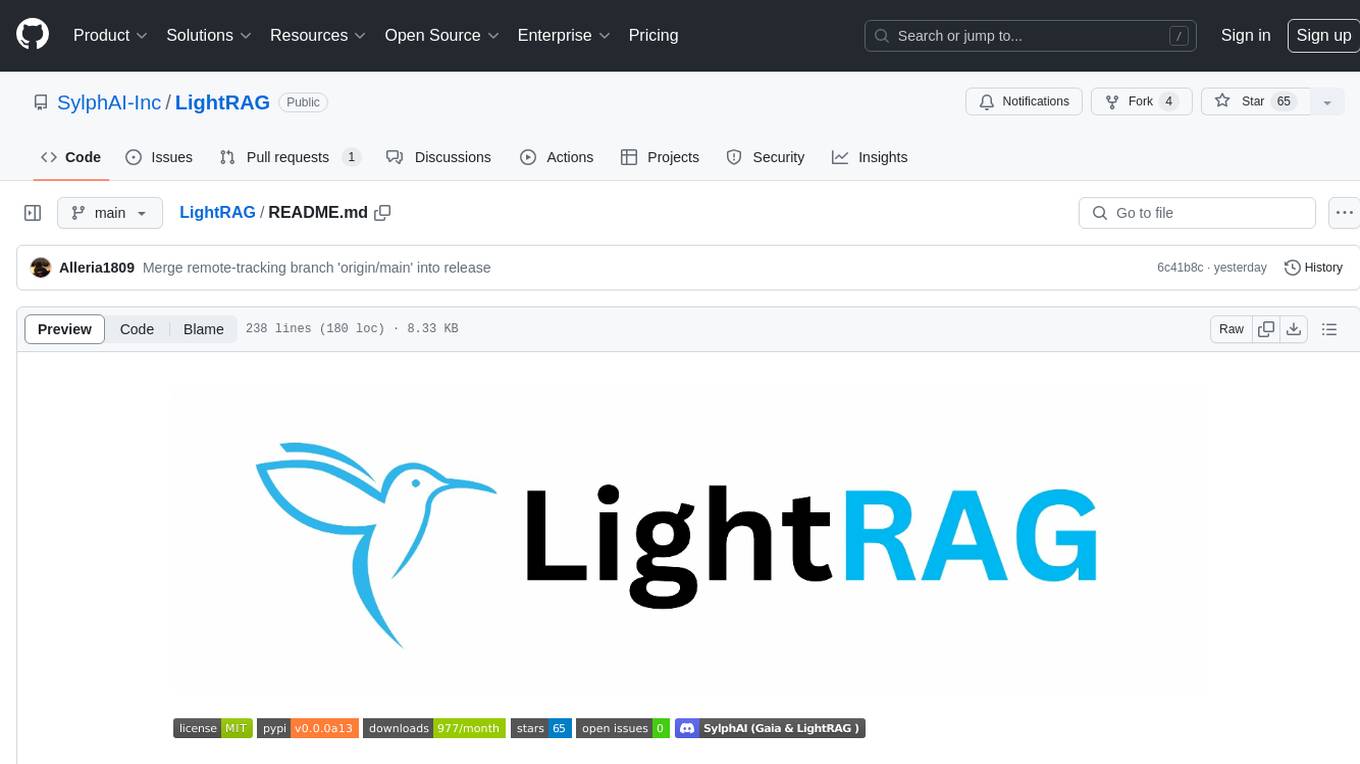
LightRAG
LightRAG is a PyTorch library designed for building and optimizing Retriever-Agent-Generator (RAG) pipelines. It follows principles of simplicity, quality, and optimization, offering developers maximum customizability with minimal abstraction. The library includes components for model interaction, output parsing, and structured data generation. LightRAG facilitates tasks like providing explanations and examples for concepts through a question-answering pipeline.
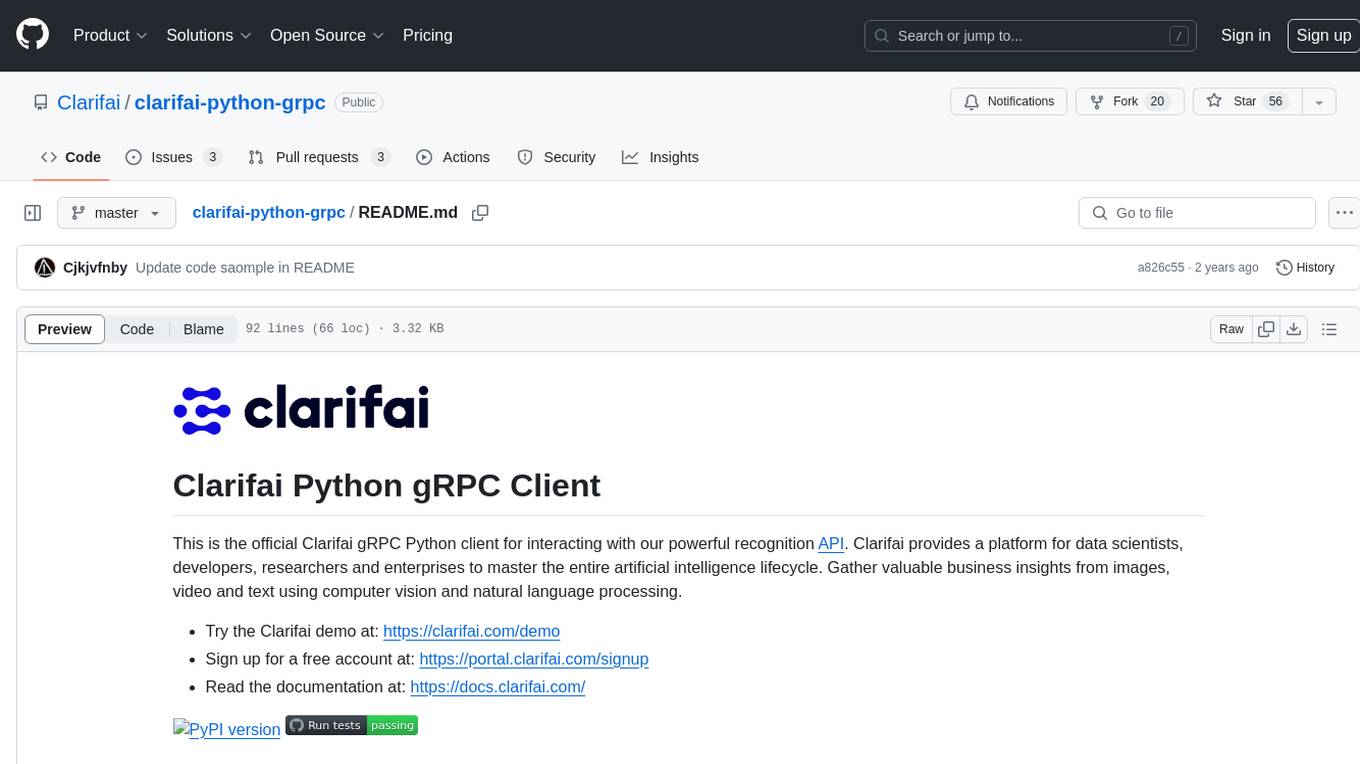
clarifai-python-grpc
This is the official Clarifai gRPC Python client for interacting with their recognition API. Clarifai offers a platform for data scientists, developers, researchers, and enterprises to utilize artificial intelligence for image, video, and text analysis through computer vision and natural language processing. The client allows users to authenticate, predict concepts in images, and access various functionalities provided by the Clarifai API. It follows a versioning scheme that aligns with the backend API updates and includes specific instructions for installation and troubleshooting. Users can explore the Clarifai demo, sign up for an account, and refer to the documentation for detailed information.
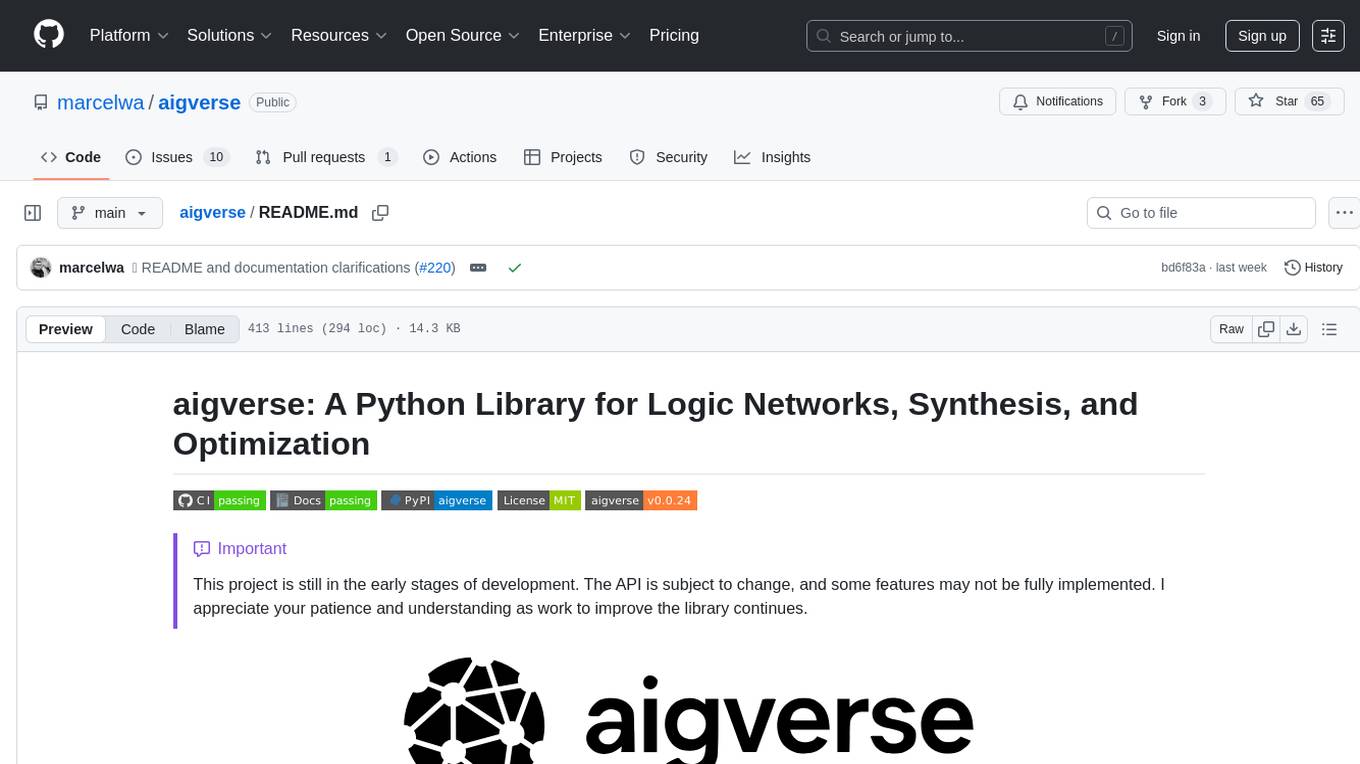
aigverse
aigverse is a Python infrastructure framework that bridges the gap between logic synthesis and AI/ML applications. It allows efficient representation and manipulation of logic circuits, making it easier to integrate logic synthesis and optimization tasks into machine learning pipelines. Built upon EPFL Logic Synthesis Libraries, particularly mockturtle, aigverse provides a high-level Python interface to state-of-the-art algorithms for And-Inverter Graph (AIG) manipulation and logic synthesis, widely used in formal verification, hardware design, and optimization tasks.
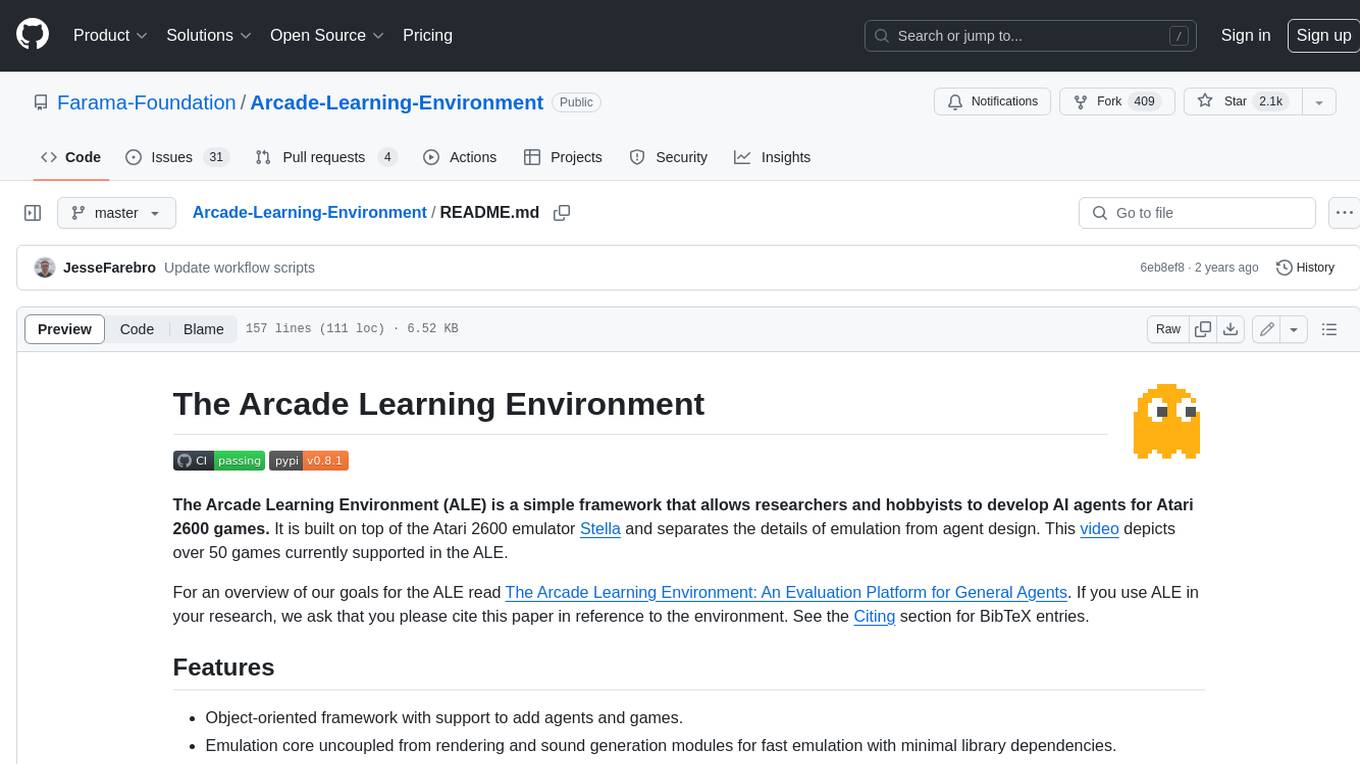
Arcade-Learning-Environment
The Arcade Learning Environment (ALE) is a simple framework that allows researchers and hobbyists to develop AI agents for Atari 2600 games. It is built on top of the Atari 2600 emulator Stella and separates the details of emulation from agent design. The ALE currently supports three different interfaces: C++, Python, and OpenAI Gym.
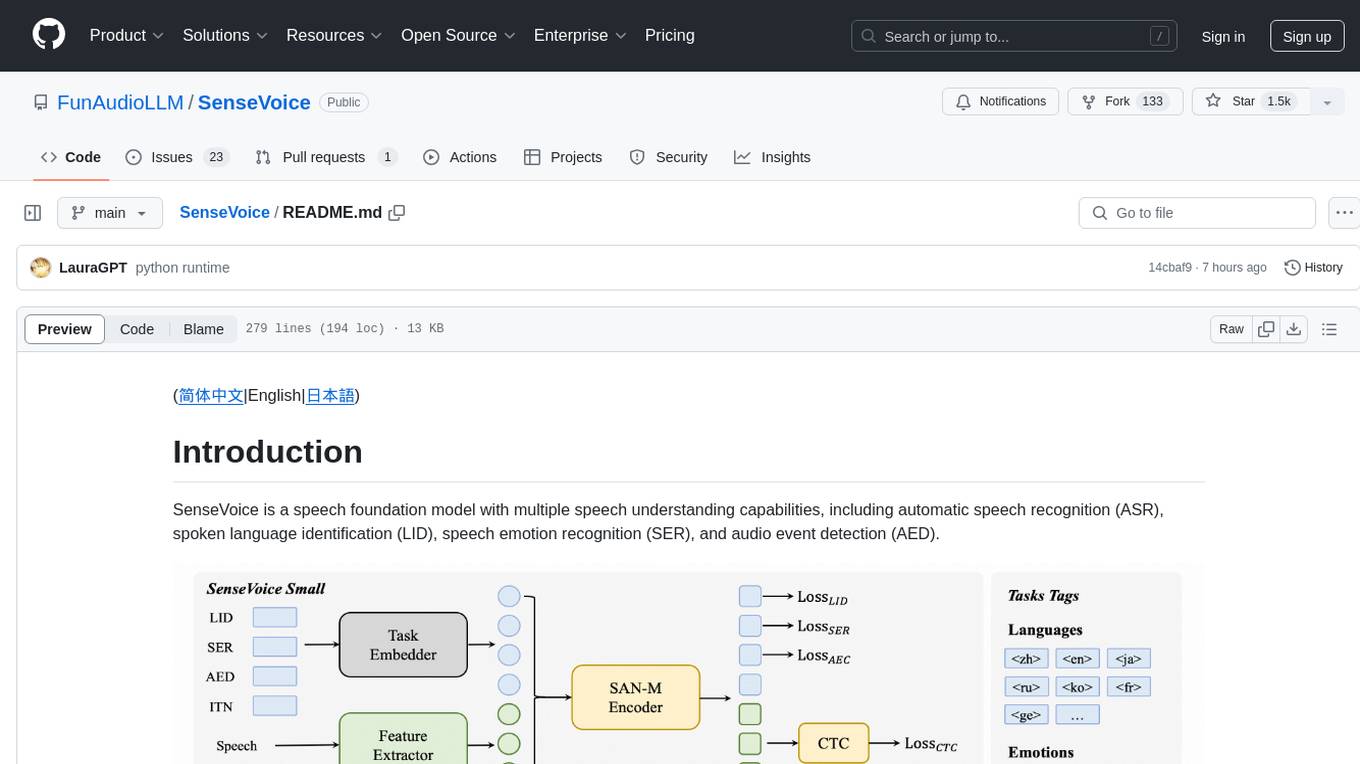
SenseVoice
SenseVoice is a speech foundation model focusing on high-accuracy multilingual speech recognition, speech emotion recognition, and audio event detection. Trained with over 400,000 hours of data, it supports more than 50 languages and excels in emotion recognition and sound event detection. The model offers efficient inference with low latency and convenient finetuning scripts. It can be deployed for service with support for multiple client-side languages. SenseVoice-Small model is open-sourced and provides capabilities for Mandarin, Cantonese, English, Japanese, and Korean. The tool also includes features for natural speech generation and fundamental speech recognition tasks.
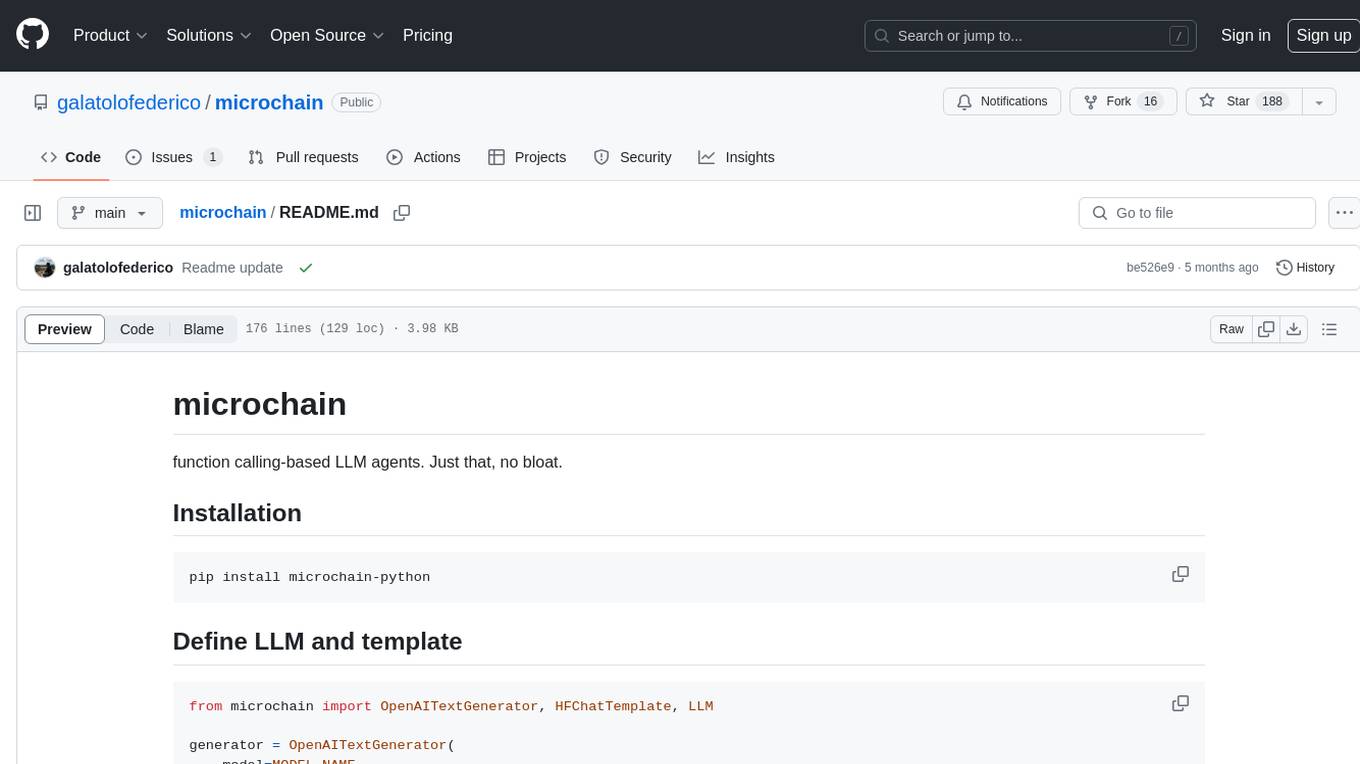
microchain
Microchain is a function calling-based LLM agents tool with no bloat. It allows users to define LLM and templates, use various functions like Sum and Product, and create LLM agents for specific tasks. The tool provides a simple and efficient way to interact with OpenAI models and create conversational agents for various applications.
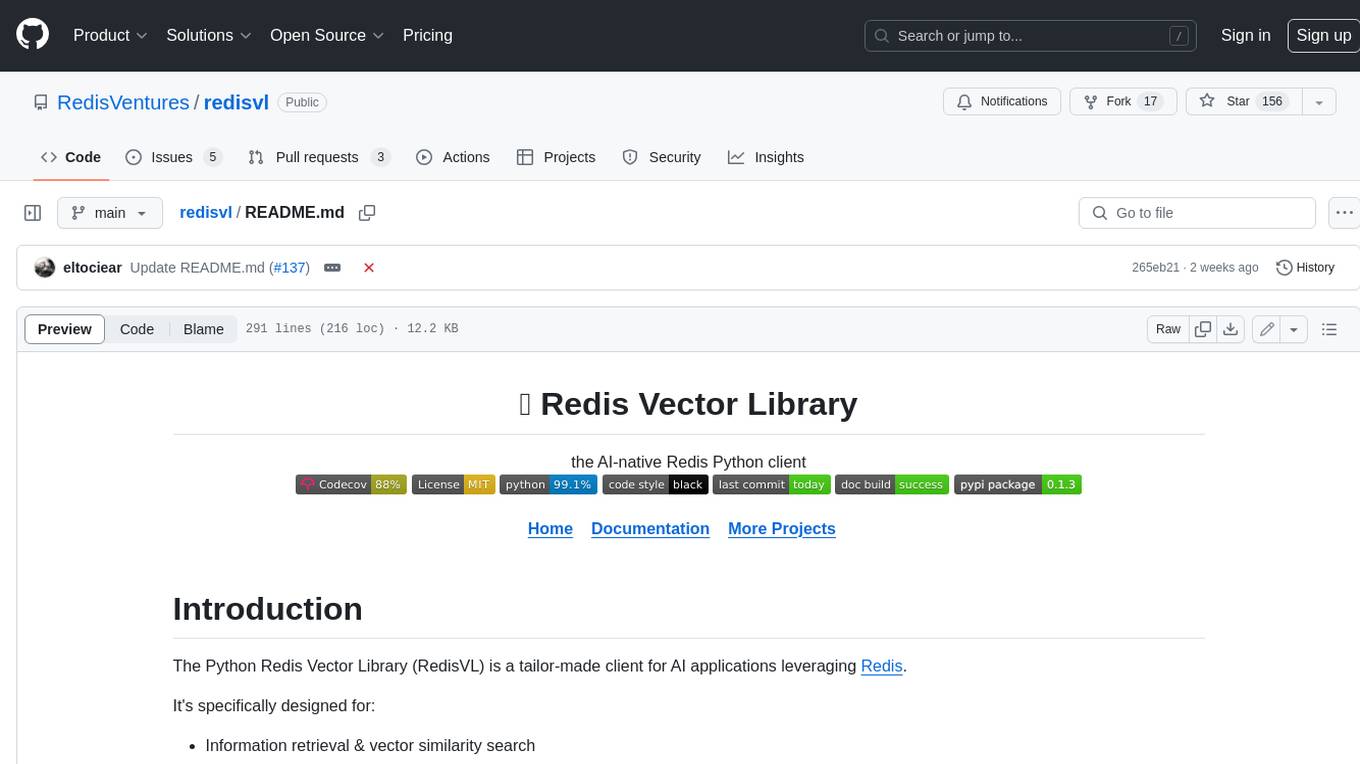
redisvl
Redis Vector Library (RedisVL) is a Python client library for building AI applications on top of Redis. It provides a high-level interface for managing vector indexes, performing vector search, and integrating with popular embedding models and providers. RedisVL is designed to make it easy for developers to build and deploy AI applications that leverage the speed, flexibility, and reliability of Redis.
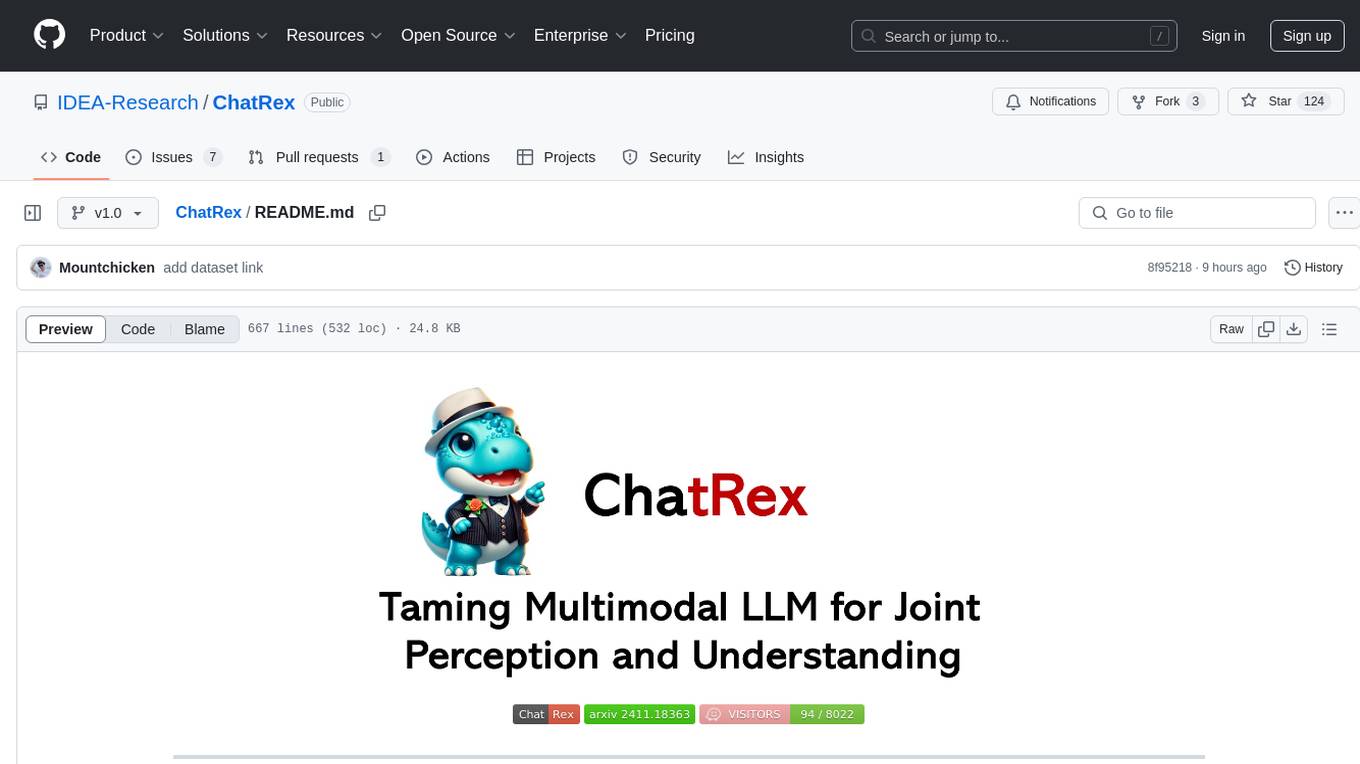
ChatRex
ChatRex is a Multimodal Large Language Model (MLLM) designed to seamlessly integrate fine-grained object perception and robust language understanding. By adopting a decoupled architecture with a retrieval-based approach for object detection and leveraging high-resolution visual inputs, ChatRex addresses key challenges in perception tasks. It is powered by the Rexverse-2M dataset with diverse image-region-text annotations. ChatRex can be applied to various scenarios requiring fine-grained perception, such as object detection, grounded conversation, grounded image captioning, and region understanding.
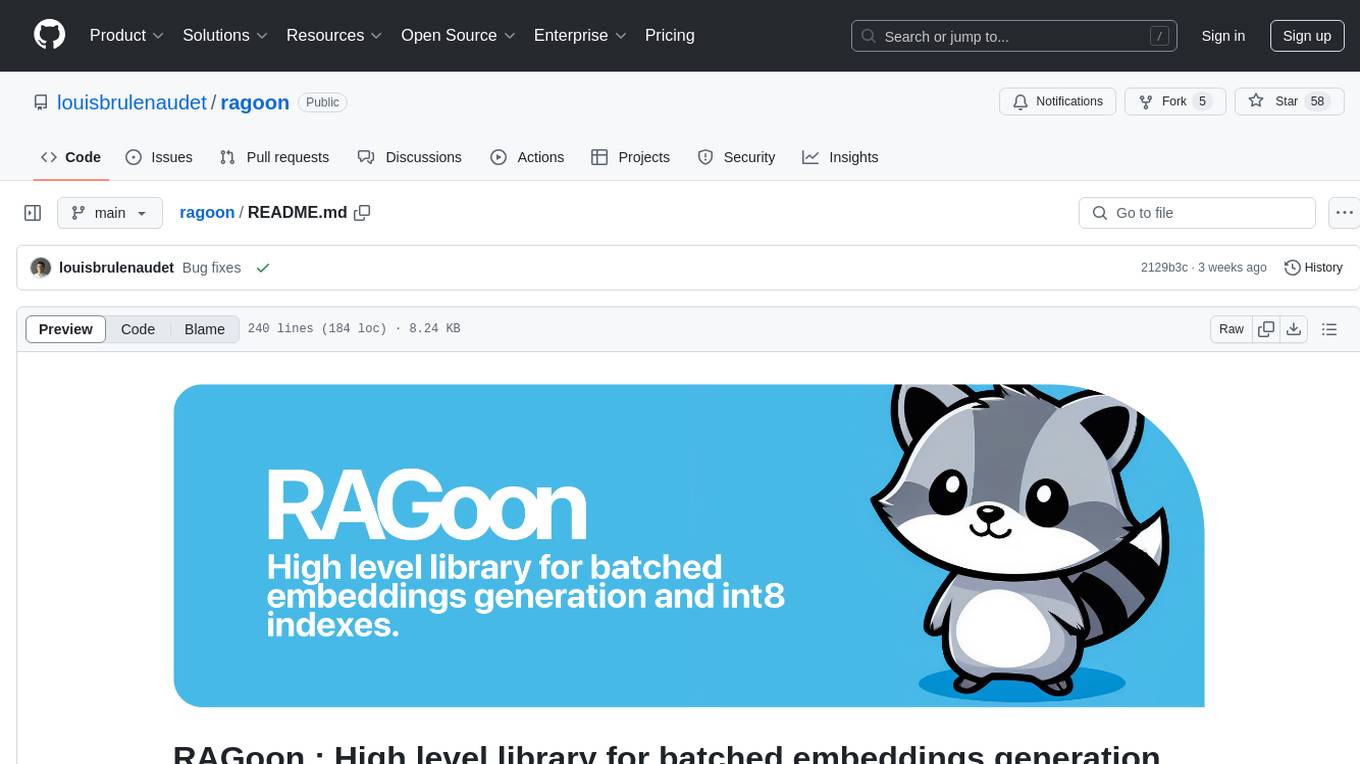
ragoon
RAGoon is a high-level library designed for batched embeddings generation, fast web-based RAG (Retrieval-Augmented Generation) processing, and quantized indexes processing. It provides NLP utilities for multi-model embedding production, high-dimensional vector visualization, and enhancing language model performance through search-based querying, web scraping, and data augmentation techniques.
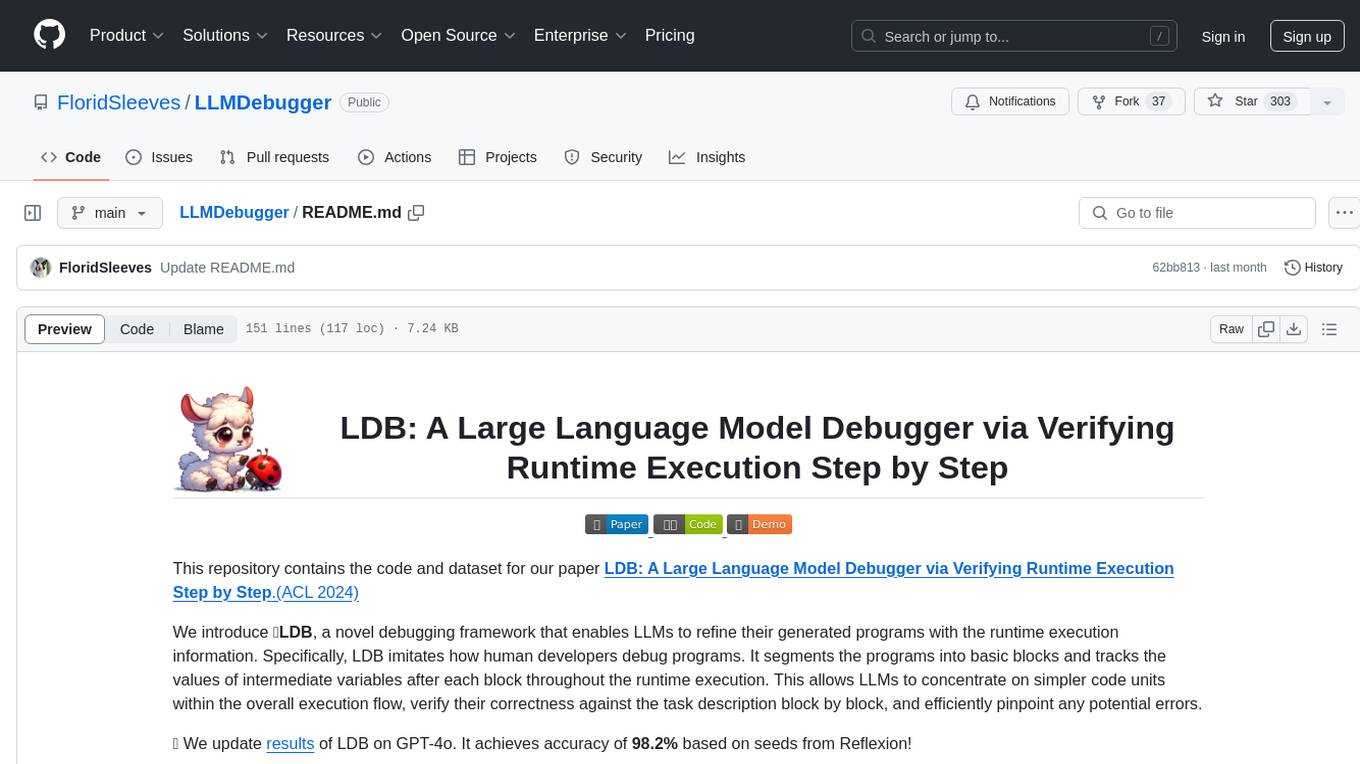
LLMDebugger
This repository contains the code and dataset for LDB, a novel debugging framework that enables Large Language Models (LLMs) to refine their generated programs by tracking the values of intermediate variables throughout the runtime execution. LDB segments programs into basic blocks, allowing LLMs to concentrate on simpler code units, verify correctness block by block, and pinpoint errors efficiently. The tool provides APIs for debugging and generating code with debugging messages, mimicking how human developers debug programs.
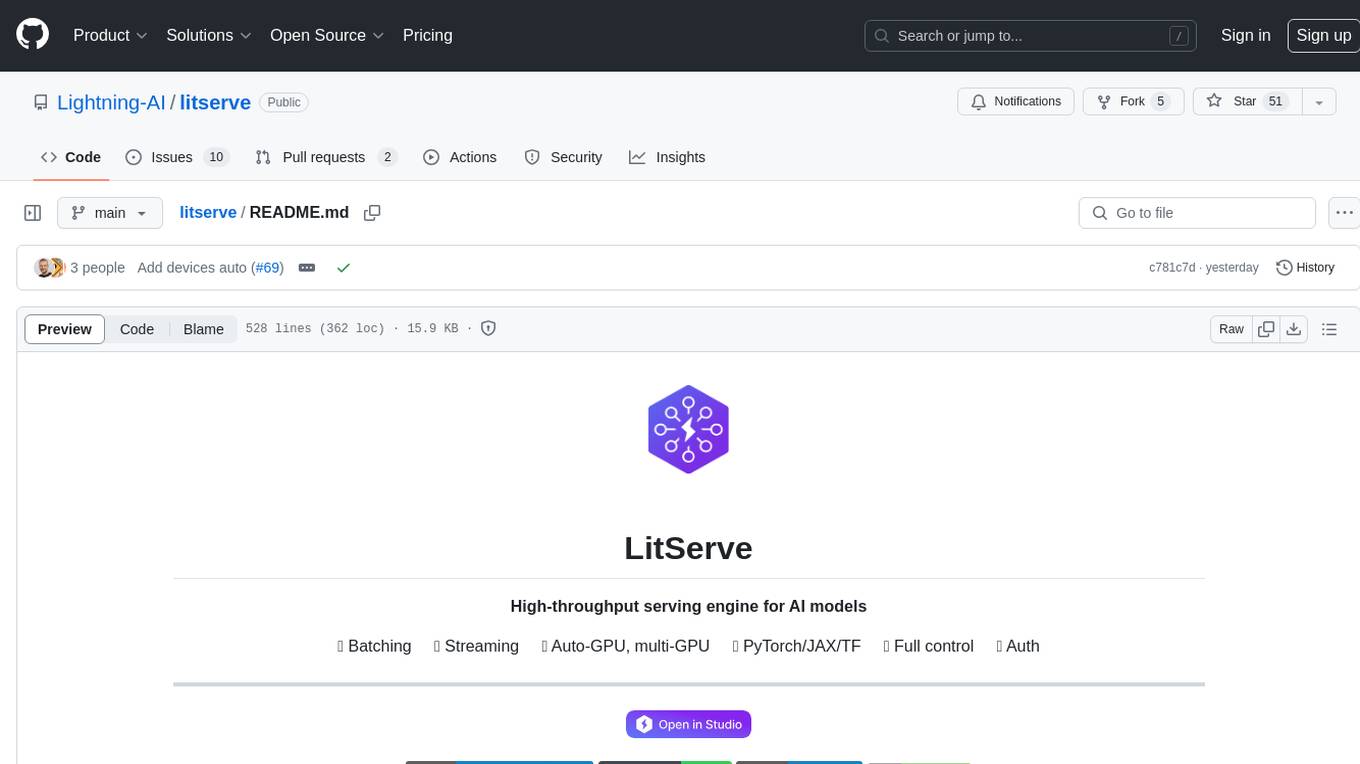
litserve
LitServe is a high-throughput serving engine for deploying AI models at scale. It generates an API endpoint for a model, handles batching, streaming, autoscaling across CPU/GPUs, and more. Built for enterprise scale, it supports every framework like PyTorch, JAX, Tensorflow, and more. LitServe is designed to let users focus on model performance, not the serving boilerplate. It is like PyTorch Lightning for model serving but with broader framework support and scalability.
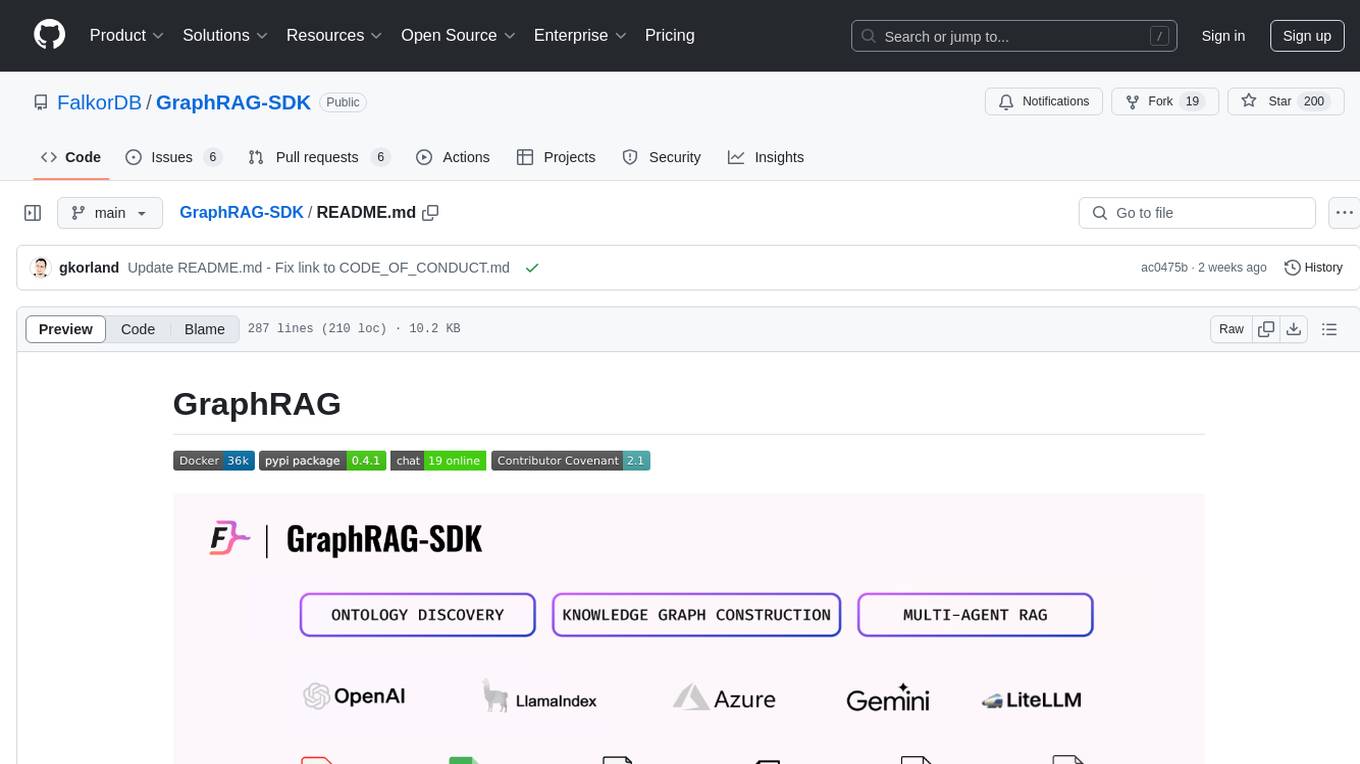
GraphRAG-SDK
Build fast and accurate GenAI applications with GraphRAG SDK, a specialized toolkit for building Graph Retrieval-Augmented Generation (GraphRAG) systems. It integrates knowledge graphs, ontology management, and state-of-the-art LLMs to deliver accurate, efficient, and customizable RAG workflows. The SDK simplifies the development process by automating ontology creation, knowledge graph agent creation, and query handling, enabling users to interact and query their knowledge graphs effectively. It supports multi-agent systems and orchestrates agents specialized in different domains. The SDK is optimized for FalkorDB, ensuring high performance and scalability for large-scale applications. By leveraging knowledge graphs, it enables semantic relationships and ontology-driven queries that go beyond standard vector similarity, enhancing retrieval-augmented generation capabilities.
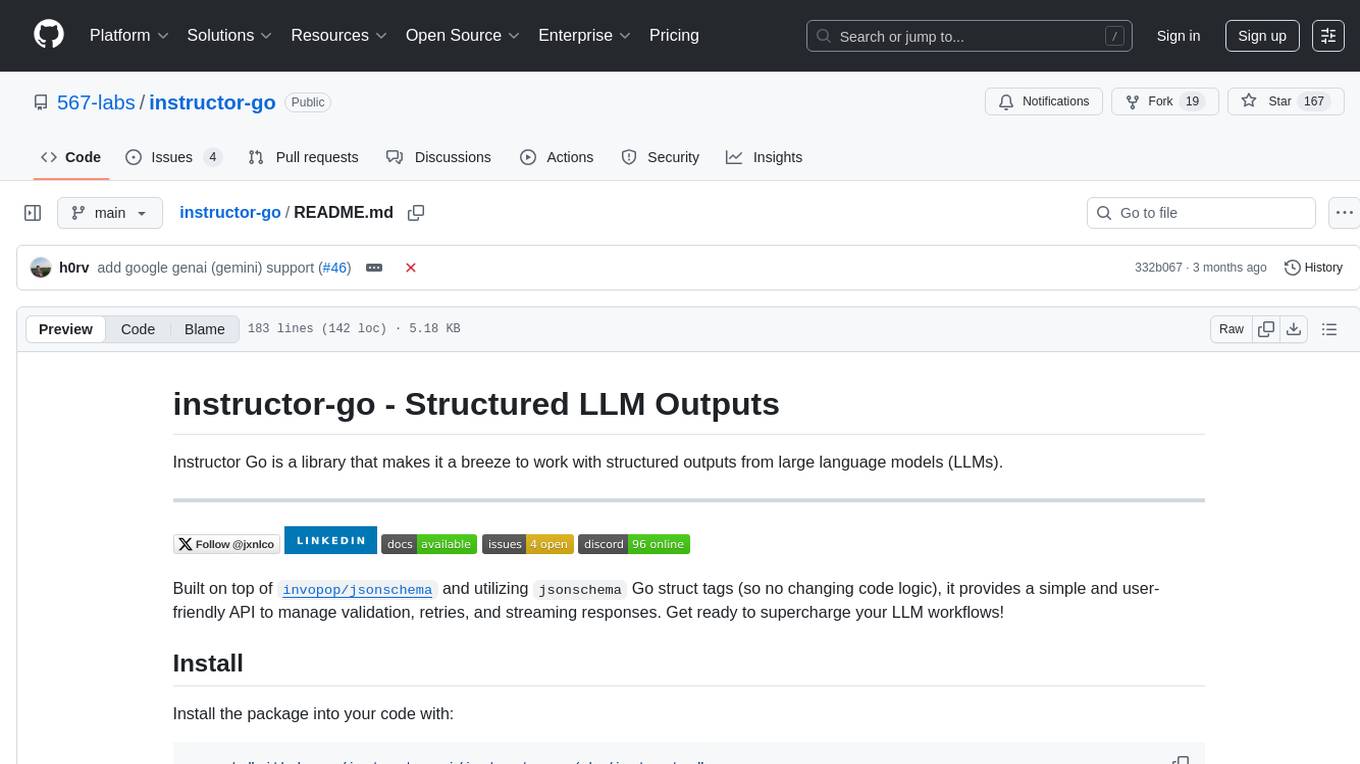
instructor-go
Instructor Go is a library that simplifies working with structured outputs from large language models (LLMs). Built on top of `invopop/jsonschema` and utilizing `jsonschema` Go struct tags, it provides a user-friendly API for managing validation, retries, and streaming responses without changing code logic. The library supports LLM provider APIs such as OpenAI, Anthropic, Cohere, and Google, capturing and returning usage data in responses. Users can easily add metadata to struct fields using `jsonschema` tags to enhance model awareness and streamline workflows.

litdata
LitData is a tool designed for blazingly fast, distributed streaming of training data from any cloud storage. It allows users to transform and optimize data in cloud storage environments efficiently and intuitively, supporting various data types like images, text, video, audio, geo-spatial, and multimodal data. LitData integrates smoothly with frameworks such as LitGPT and PyTorch, enabling seamless streaming of data to multiple machines. Key features include multi-GPU/multi-node support, easy data mixing, pause & resume functionality, support for profiling, memory footprint reduction, cache size configuration, and on-prem optimizations. The tool also provides benchmarks for measuring streaming speed and conversion efficiency, along with runnable templates for different data types. LitData enables infinite cloud data processing by utilizing the Lightning.ai platform to scale data processing with optimized machines.

generative-ai
The 'Generative AI' repository provides a C# library for interacting with Google's Generative AI models, specifically the Gemini models. It allows users to access and integrate the Gemini API into .NET applications, supporting functionalities such as listing available models, generating content, creating tuned models, working with large files, starting chat sessions, and more. The repository also includes helper classes and enums for Gemini API aspects. Authentication methods include API key, OAuth, and various authentication modes for Google AI and Vertex AI. The package offers features for both Google AI Studio and Google Cloud Vertex AI, with detailed instructions on installation, usage, and troubleshooting.
For similar tasks

xlstm
xLSTM is a new Recurrent Neural Network architecture based on ideas of the original LSTM. Through Exponential Gating with appropriate normalization and stabilization techniques and a new Matrix Memory it overcomes the limitations of the original LSTM and shows promising performance on Language Modeling when compared to Transformers or State Space Models. The package is based on PyTorch and was tested for versions >=1.8. For the CUDA version of xLSTM, you need Compute Capability >= 8.0. The xLSTM tool provides two main components: xLSTMBlockStack for non-language applications or integrating in other architectures, and xLSTMLMModel for language modeling or other token-based applications.
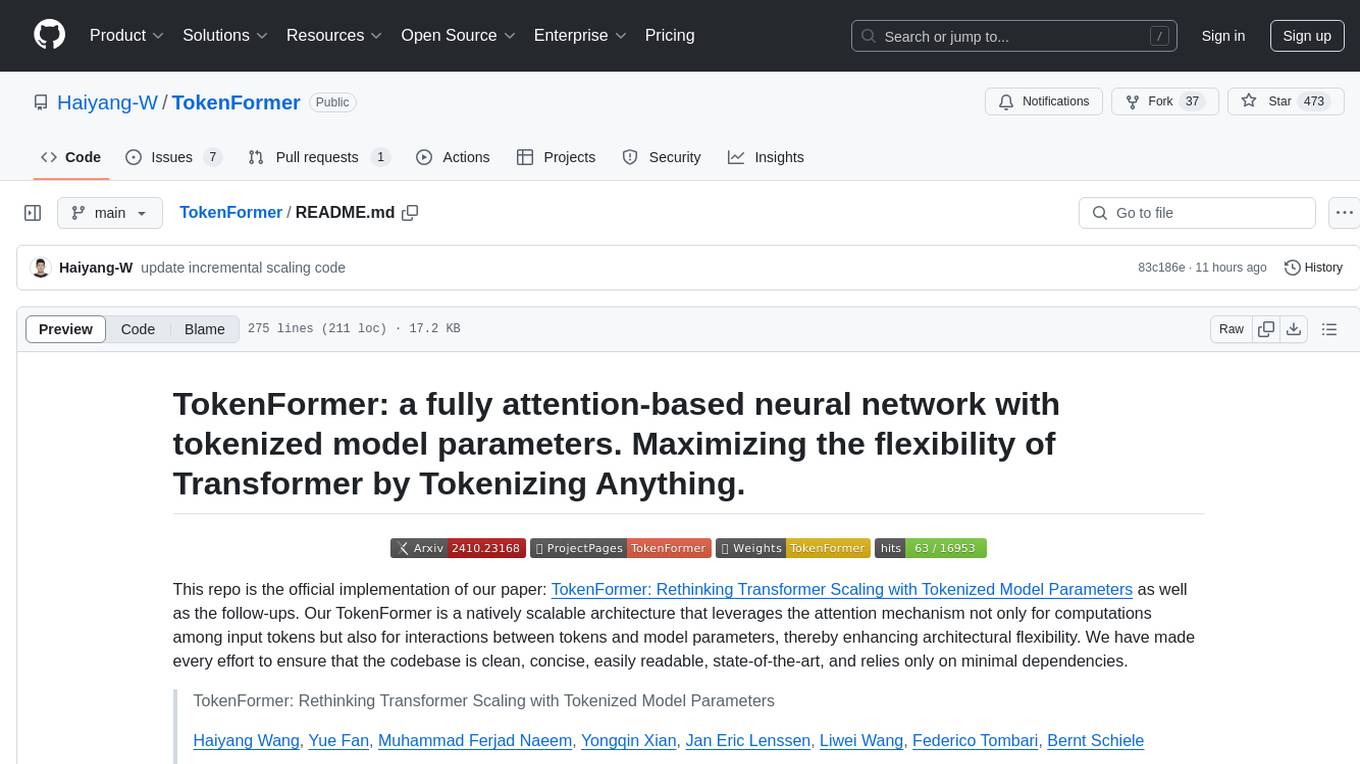
TokenFormer
TokenFormer is a fully attention-based neural network architecture that leverages tokenized model parameters to enhance architectural flexibility. It aims to maximize the flexibility of neural networks by unifying token-token and token-parameter interactions through the attention mechanism. The architecture allows for incremental model scaling and has shown promising results in language modeling and visual modeling tasks. The codebase is clean, concise, easily readable, state-of-the-art, and relies on minimal dependencies.

ai-on-gke
This repository contains assets related to AI/ML workloads on Google Kubernetes Engine (GKE). Run optimized AI/ML workloads with Google Kubernetes Engine (GKE) platform orchestration capabilities. A robust AI/ML platform considers the following layers: Infrastructure orchestration that support GPUs and TPUs for training and serving workloads at scale Flexible integration with distributed computing and data processing frameworks Support for multiple teams on the same infrastructure to maximize utilization of resources
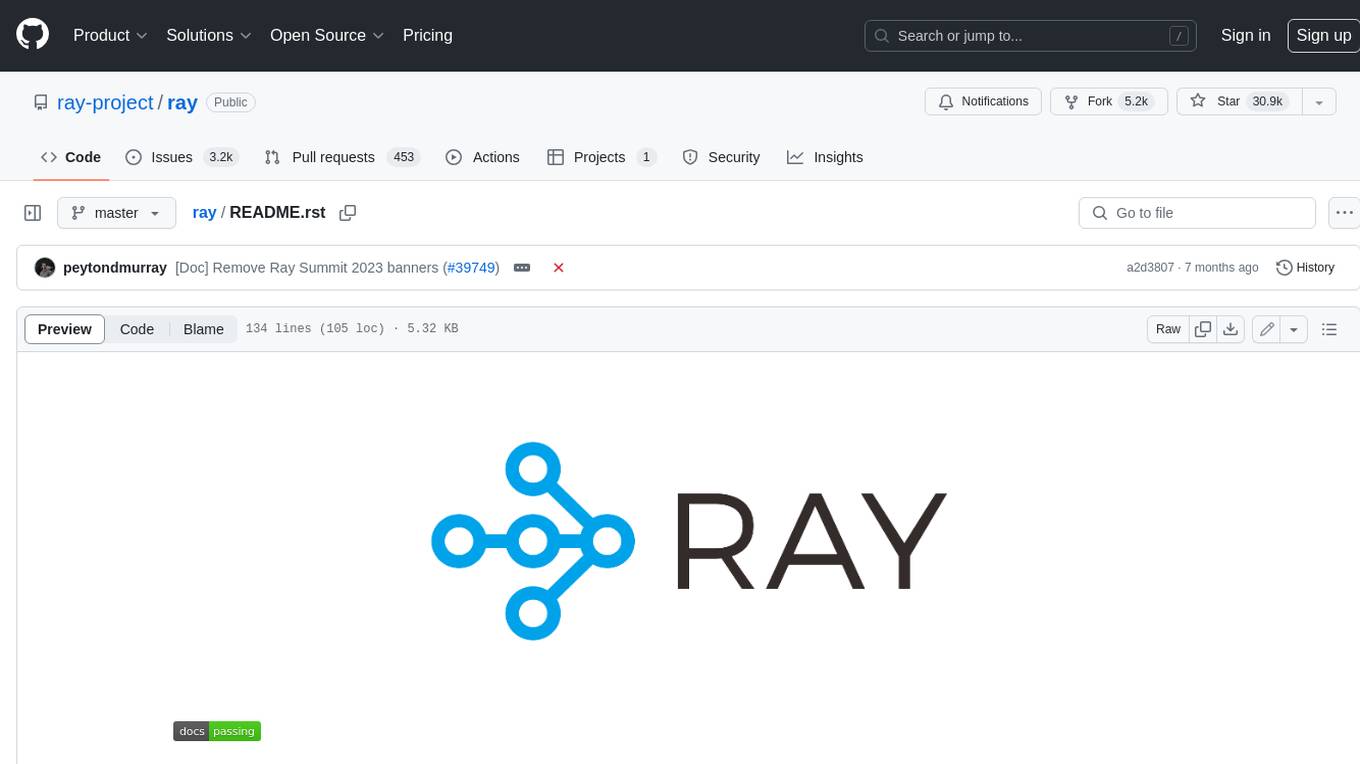
ray
Ray is a unified framework for scaling AI and Python applications. It consists of a core distributed runtime and a set of AI libraries for simplifying ML compute, including Data, Train, Tune, RLlib, and Serve. Ray runs on any machine, cluster, cloud provider, and Kubernetes, and features a growing ecosystem of community integrations. With Ray, you can seamlessly scale the same code from a laptop to a cluster, making it easy to meet the compute-intensive demands of modern ML workloads.

labelbox-python
Labelbox is a data-centric AI platform for enterprises to develop, optimize, and use AI to solve problems and power new products and services. Enterprises use Labelbox to curate data, generate high-quality human feedback data for computer vision and LLMs, evaluate model performance, and automate tasks by combining AI and human-centric workflows. The academic & research community uses Labelbox for cutting-edge AI research.
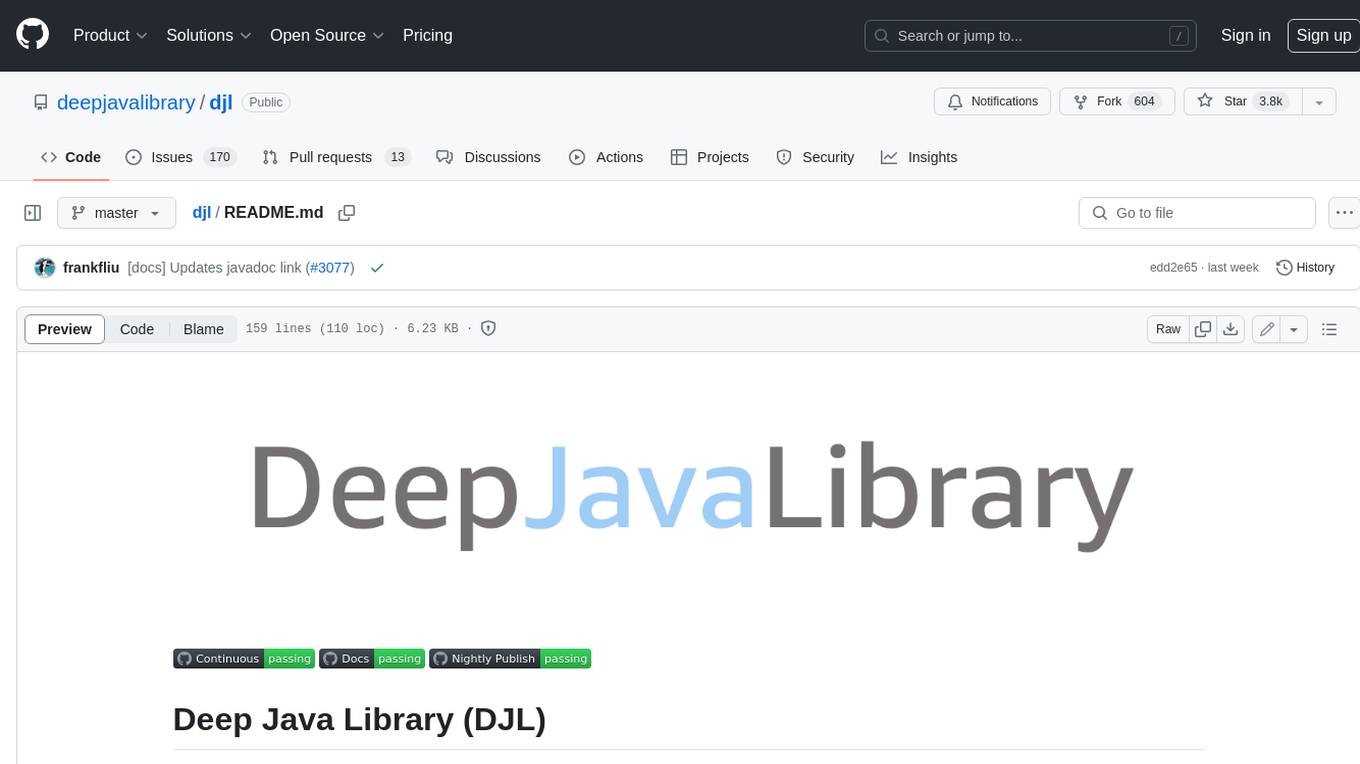
djl
Deep Java Library (DJL) is an open-source, high-level, engine-agnostic Java framework for deep learning. It is designed to be easy to get started with and simple to use for Java developers. DJL provides a native Java development experience and allows users to integrate machine learning and deep learning models with their Java applications. The framework is deep learning engine agnostic, enabling users to switch engines at any point for optimal performance. DJL's ergonomic API interface guides users with best practices to accomplish deep learning tasks, such as running inference and training neural networks.
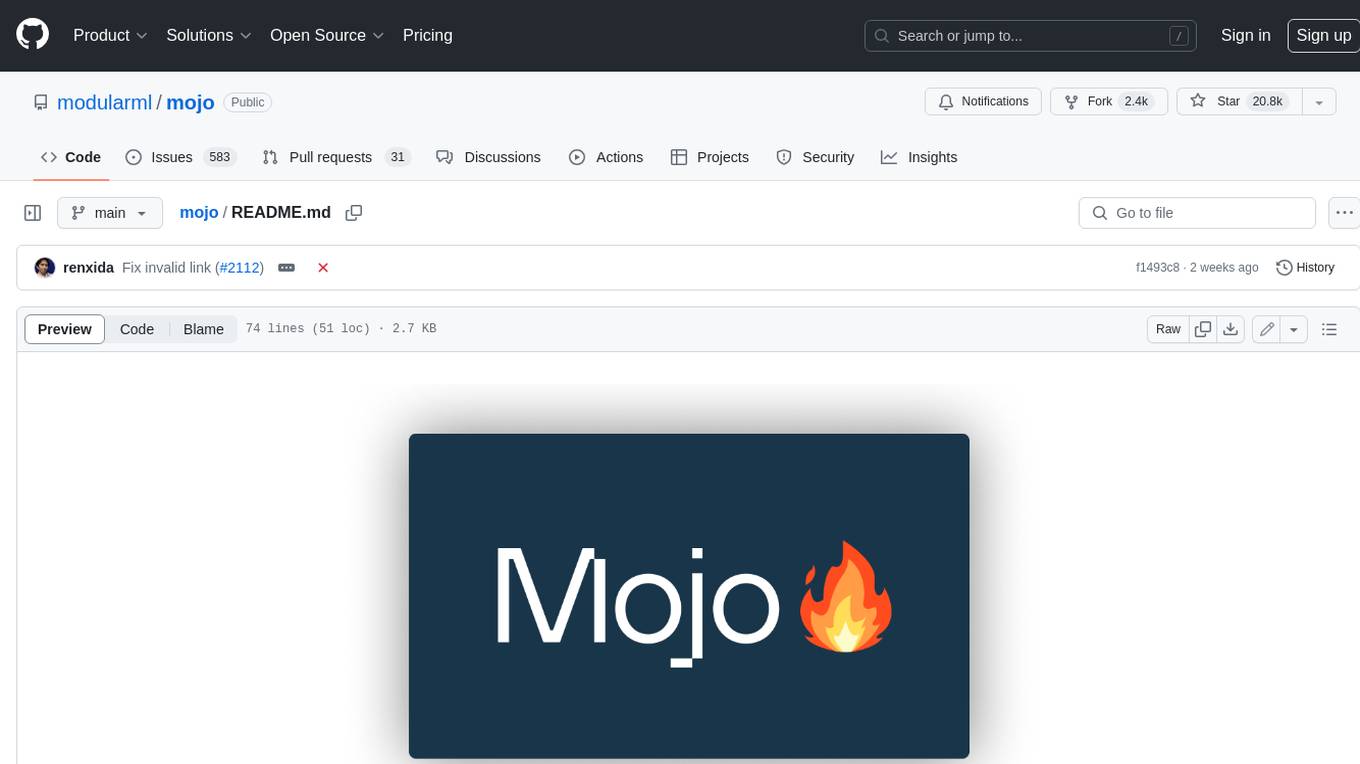
mojo
Mojo is a new programming language that bridges the gap between research and production by combining Python syntax and ecosystem with systems programming and metaprogramming features. Mojo is still young, but it is designed to become a superset of Python over time.

tt-metal
TT-NN is a python & C++ Neural Network OP library. It provides a low-level programming model, TT-Metalium, enabling kernel development for Tenstorrent hardware.
For similar jobs

sweep
Sweep is an AI junior developer that turns bugs and feature requests into code changes. It automatically handles developer experience improvements like adding type hints and improving test coverage.

teams-ai
The Teams AI Library is a software development kit (SDK) that helps developers create bots that can interact with Teams and Microsoft 365 applications. It is built on top of the Bot Framework SDK and simplifies the process of developing bots that interact with Teams' artificial intelligence capabilities. The SDK is available for JavaScript/TypeScript, .NET, and Python.

ai-guide
This guide is dedicated to Large Language Models (LLMs) that you can run on your home computer. It assumes your PC is a lower-end, non-gaming setup.

classifai
Supercharge WordPress Content Workflows and Engagement with Artificial Intelligence. Tap into leading cloud-based services like OpenAI, Microsoft Azure AI, Google Gemini and IBM Watson to augment your WordPress-powered websites. Publish content faster while improving SEO performance and increasing audience engagement. ClassifAI integrates Artificial Intelligence and Machine Learning technologies to lighten your workload and eliminate tedious tasks, giving you more time to create original content that matters.

chatbot-ui
Chatbot UI is an open-source AI chat app that allows users to create and deploy their own AI chatbots. It is easy to use and can be customized to fit any need. Chatbot UI is perfect for businesses, developers, and anyone who wants to create a chatbot.

BricksLLM
BricksLLM is a cloud native AI gateway written in Go. Currently, it provides native support for OpenAI, Anthropic, Azure OpenAI and vLLM. BricksLLM aims to provide enterprise level infrastructure that can power any LLM production use cases. Here are some use cases for BricksLLM: * Set LLM usage limits for users on different pricing tiers * Track LLM usage on a per user and per organization basis * Block or redact requests containing PIIs * Improve LLM reliability with failovers, retries and caching * Distribute API keys with rate limits and cost limits for internal development/production use cases * Distribute API keys with rate limits and cost limits for students

uAgents
uAgents is a Python library developed by Fetch.ai that allows for the creation of autonomous AI agents. These agents can perform various tasks on a schedule or take action on various events. uAgents are easy to create and manage, and they are connected to a fast-growing network of other uAgents. They are also secure, with cryptographically secured messages and wallets.

griptape
Griptape is a modular Python framework for building AI-powered applications that securely connect to your enterprise data and APIs. It offers developers the ability to maintain control and flexibility at every step. Griptape's core components include Structures (Agents, Pipelines, and Workflows), Tasks, Tools, Memory (Conversation Memory, Task Memory, and Meta Memory), Drivers (Prompt and Embedding Drivers, Vector Store Drivers, Image Generation Drivers, Image Query Drivers, SQL Drivers, Web Scraper Drivers, and Conversation Memory Drivers), Engines (Query Engines, Extraction Engines, Summary Engines, Image Generation Engines, and Image Query Engines), and additional components (Rulesets, Loaders, Artifacts, Chunkers, and Tokenizers). Griptape enables developers to create AI-powered applications with ease and efficiency.